General Methodology for Creative Problem Solving and Task Achieving -Its Plan-
Toru Nakagawa (Osaka Gakuin University, Professor Emeritus)
at Istitute of Mathematical Statistics, Tachikawa, Tokyo
General Methodology for Creative Problem Solving and Task Achieving -Its Plan- |
|
| Toru Nakagawa (Osaka Gakuin University, Professor Emeritus) |
|
| Presented at 9th TRIZ Symposium in Japan, Held on Sept. 5-6, 2013 at Istitute of Mathematical Statistics, Tachikawa, Tokyo |
|
| [Posted: Dec. 9, 2013] |
For going back to Japanese pages, press buttons.
Editor's Note (Toru Nakagawa, Dec. 7, 2013)
This is the paper presented at Japan TRIZ Symposium 2013 last September. Its Abstract (submitted in May 2013) and its presentation slides are posted here in English and in Japanese.
This page, in fact, was almost ready to post by Sept. 22 and I mistakenly thought till today that I had already posted it in my Web site. When I posted several articles on Oct. 3, I lost this page and after passing 2 months I have just recognized my mistake today.
Please refer to the Abstract concerning to the motive and contents of the paper. My presentation slides are composed of the following 3 parts:
Part 1: Beyond TRIZ, A New Target at a higher level
Part 2: Strategies for establishing the new target
Part 3: Conceptual plan of the general methodology of creative problem solvingThe present paper puts emphasis on the Part 2 above, i.e., the strategies for constructing the CrePS methodology. Thus it forms the basis of the paper on 'the vision of CrePS'

, on which I presented at the conferences of Japan Creativity Society and of ETRIA TFC 2013 in late October. For more details of the General methodology CrePS, please refer to 'the CrePS Vision page
.
| Top of the page | Abstract | Abstract PDF |
Slides | Part 1 | Part 2 | Part 3 | Concluding | Slides PDF |
Japan TRIZ Symp. Report (Nakagawa) |
CrePS Vision |
Japanese page |
Abstract (Submitted on May 15, 2013) PDF
General Methodology for Creative Problem Solving and Task Achieving
-- Its Plan --Toru Nakagawa (Osaka Gakuin University, Professor Emeritus)
9th TRIZ Symposium in Japan, held on Sept. 5-6, 2013 in Tokyo
Abstract
TRIZ has been established as a methodology of 'Invention', and extended to be a methodology of 'Technical Innovation' and further to be a methodology for 'Innovation' including non-technical applications. However, we should better extend it in a more general sense as a methodology for creative problem solving and task achieving. In the present paper I will describe a plan for establishing such a general methodology.
By unifying TRIZ/USIT and various other methods, we should establish a methodology simple and easy to understand and apply. For this purpose we will adopt the Six-Box Scheme as the new paradigm for creative problem solving. We build a methodology for technical fields and another for non-technical fields, in a parallel manner. Using the data flow as the basic representation scheme, we should specify the information necessary for input, intermediate, and output of each stage; the information need to be described in terms of clearly-defined concepts and in some standardized representation methods. The ways of obtaining and deriving such information at each stage may allow alternatives. Besides these logical aspects we should also take consideration of psychological aspects of the problem solver and of the stakeholders.
Under these strategies, we should make a cooperative work of describing various methods including TRIZ/USIT. Such a cooperative work will help to form a common understanding and further to establish a unified general methodology for creative problem solving and task achieving. It will also form the basis of proliferating the general methodology.
Presentation Slides: Slides in HTML (this page) Slides in PDF
Slides in Japanese in HTML Slides in Japanese in PDF
Table of Contents
| Introduction | Title; Outline of presentation | |
| Part 1: Beyond TRIZ, A New Target at a higher level | Motive | |
| Models for learning and mastering TRIZ | Personal learning; Mastering TRIZ for engineers | |
| Areas for TRIZ application | Overview of the areas for TRIZ application |
|
| Recognizing a new, higher level target | Coclusion for Part 1; A new target | |
| Part 2: Strategies for establishing the new target | Outline | |
| Conventional methods for creative problem solving | Approaches of conventional methods; Various methods in conventional and TRIZ approaches |
|
| Clarifying the target of our new methodology | Target of our new methodology; Strategies (A) to (G) for establishing the methodology |
|
Strategies (A) Introducing a new paradigm |
(A) Conventional paradigm (Four-Box Scheme); TRIZ Tools; New paradigm (Six-Box Scheme); Characteristics of the Six-Box Scheme; Real World and Thinking World in the Six-Box Scheme |
|
| Strategies (B)~(G) | (B) For technologies and for non-technologies; (C) Data flow representation; (D) Allow different alternative processes; (E) Taking care of mental/psychological aspects; (F) Establishing first in the Thinking World (G) Describing TRIZ/USIT methods first |
|
| Part 3: Conceptual plan of the general methodology of creative problem solving | Outline | |
| General methodology of creative problem solving | Main part (for technologies); Overall requirements (for technologies); Main part (for non-technological applications) | |
| Concluding | Concluding remarks; Thanks | |
Introduction
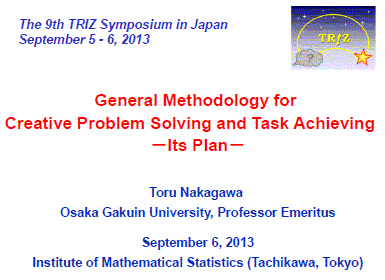
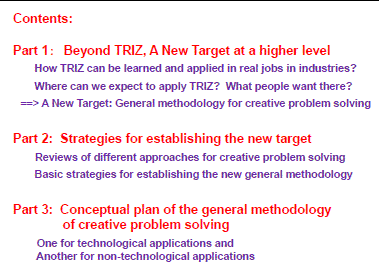
Part 1: Beyond TRIZ, A New Target at a higher level
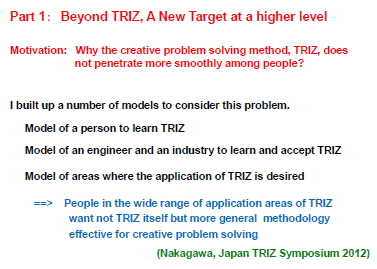
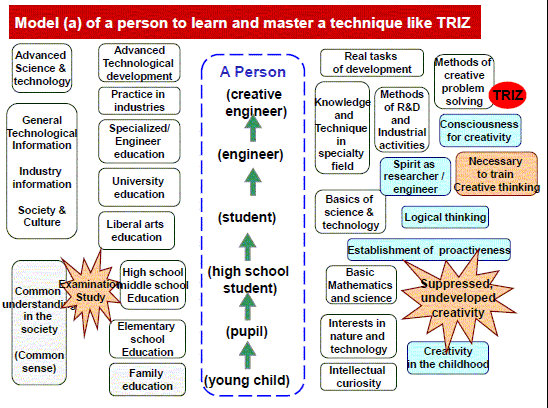
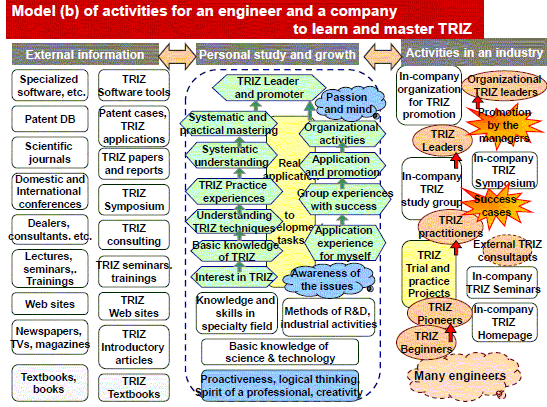
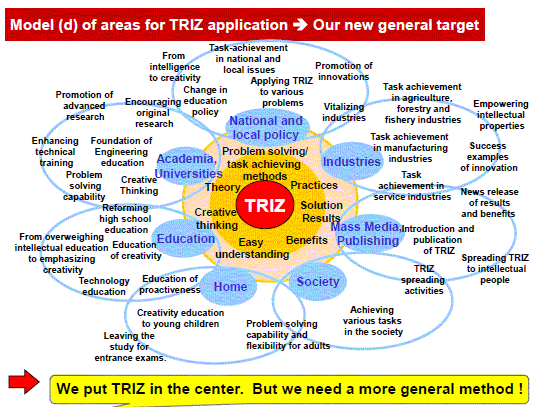
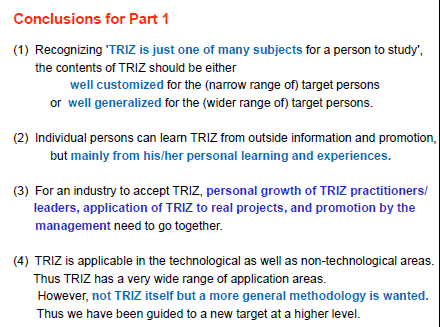
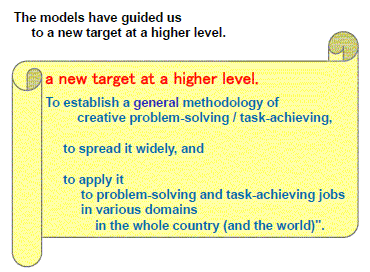
Part 2: Strategies for establishing the new target
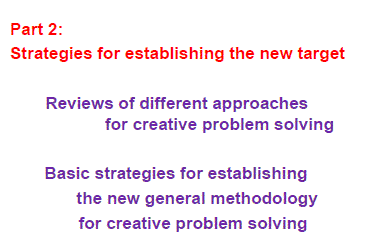
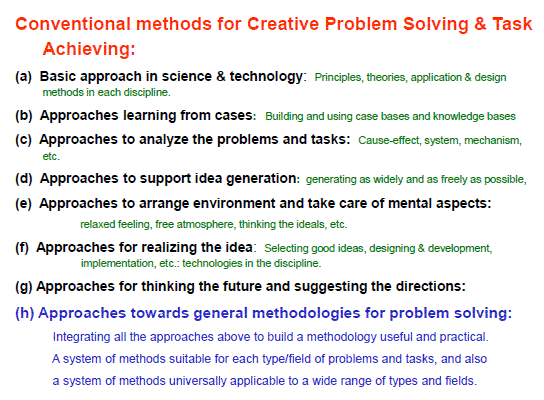
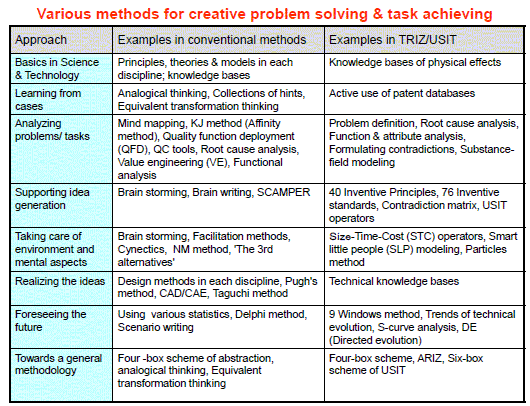
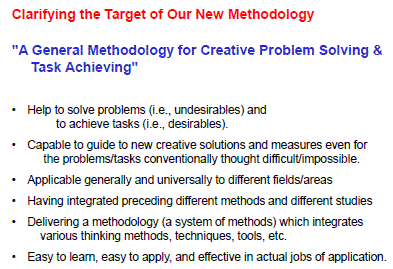
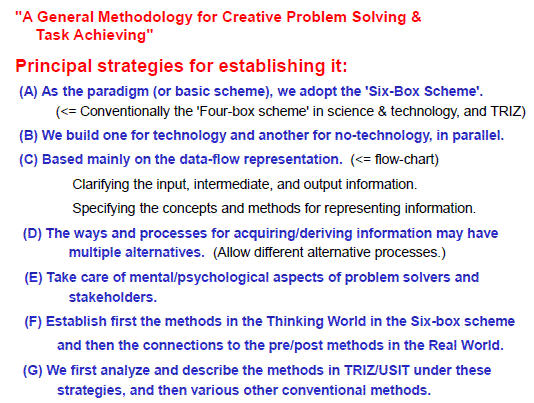
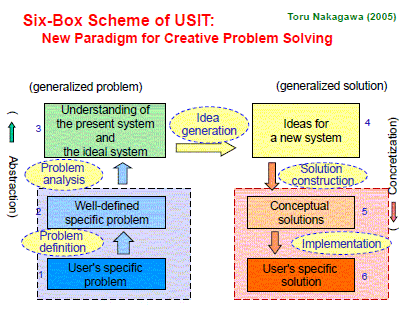
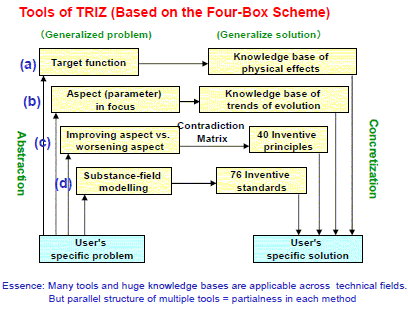
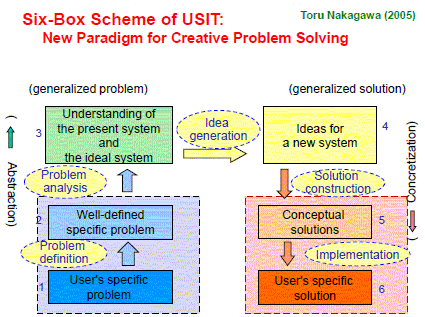
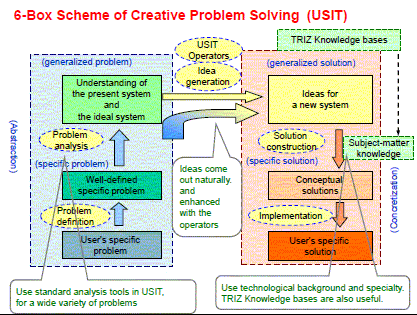
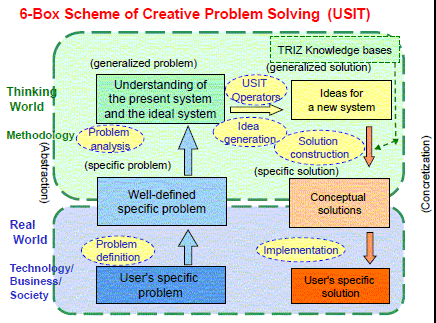
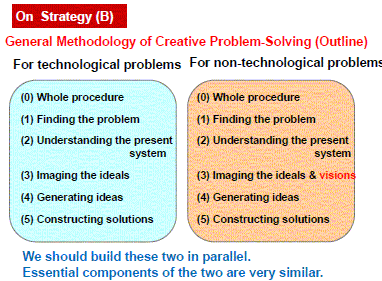
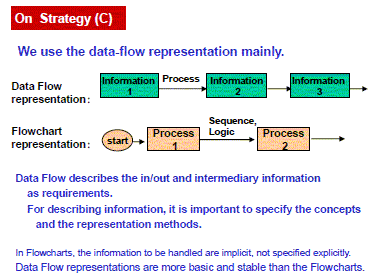
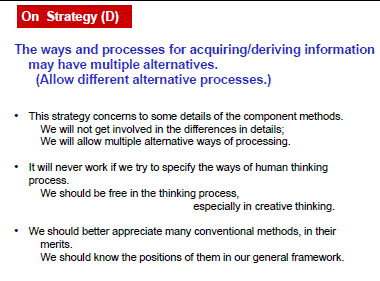
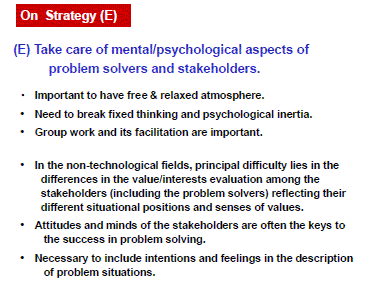
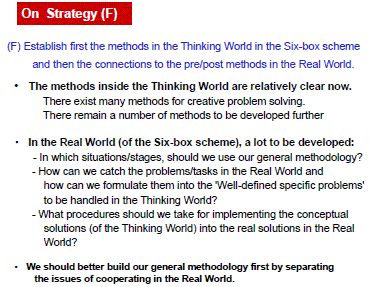
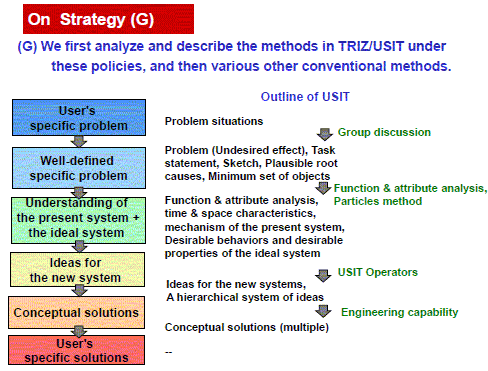
Part 3: Conceptual plan of the general methodology of creative problem solving
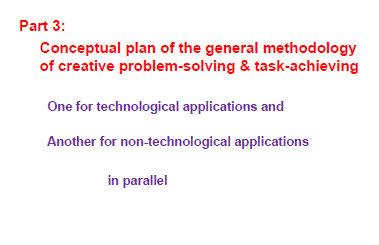
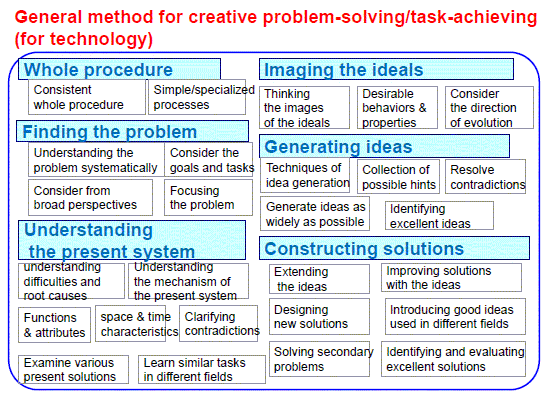
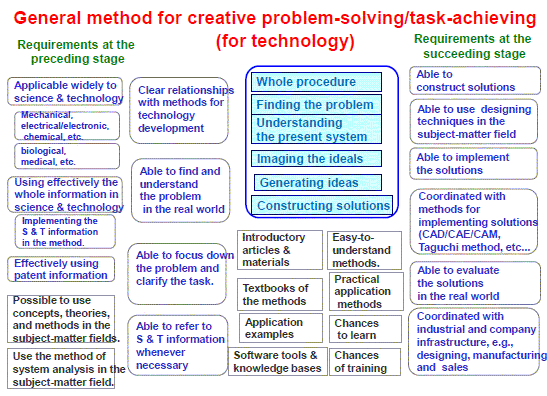
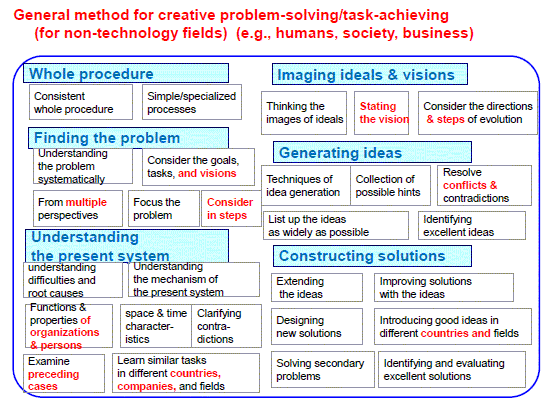
Concluding Remarks
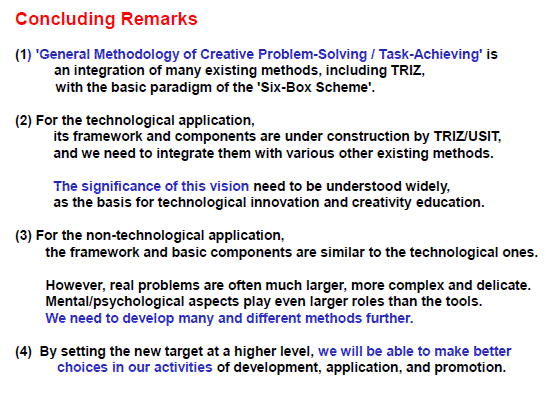
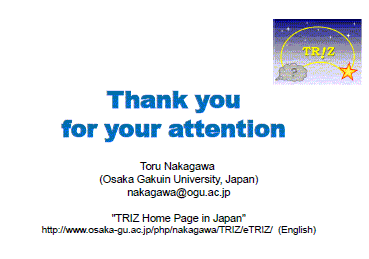
| Top of the page | Abstract | Abstract PDF |
Slides | Part 1 | Part 2 | Part 3 | Concluding | Slides PDF |
Japan TRIZ Symp. Report (Nakagawa) |
CrePS Vision |
Japanese page |
Last updated on Dec. 9, 2013. Access point: Editor: nakagawa@ogu.ac.jp